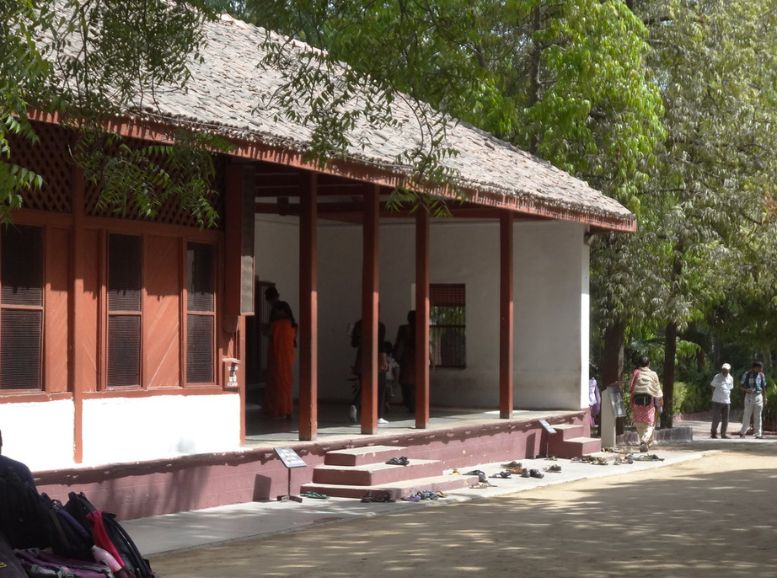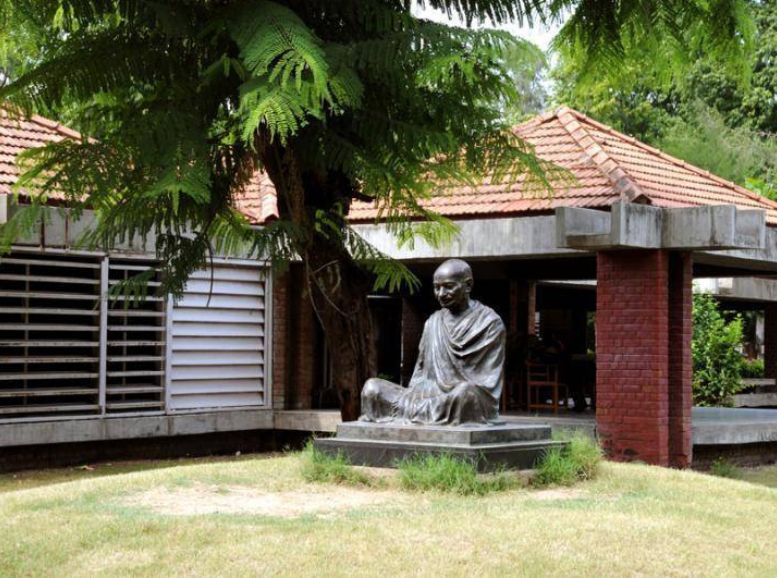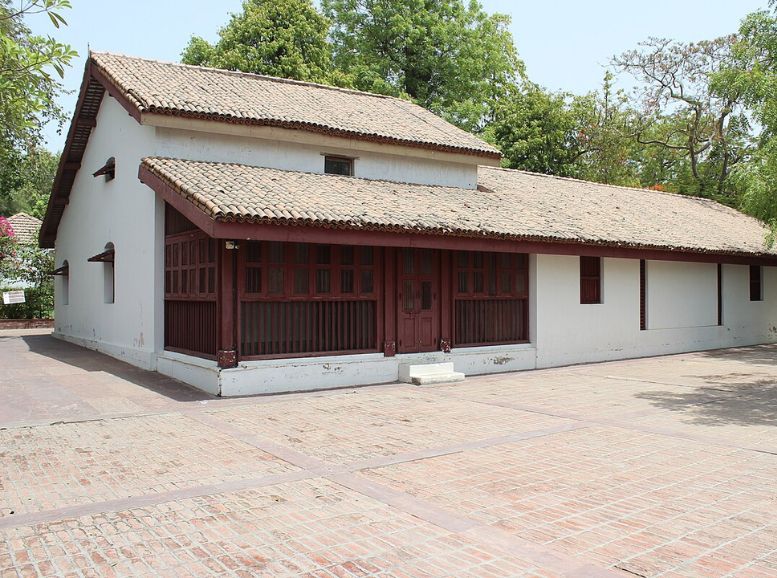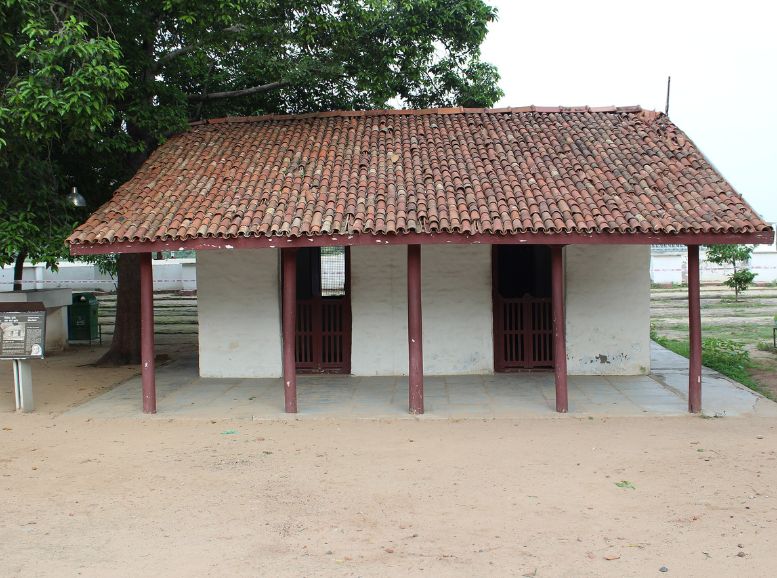Bathed in the gentle light of Ahmedabad, Sabarmati Ashram stands serenely on the banks of the Sabarmati River. This isn’t just a historical site; it’s a powerful testament to Mahatma Gandhi, the revered “Father of the Nation.” Founded in 1917, the ashram was Gandhi’s residence for over a decade and the epicenter of India’s fight for independence. These walls silently witnessed history in the making, including the launch of the iconic Dandi Salt March in 1930.
Today, Sabarmati Ashram transcends a museum. It’s a vibrant space that keeps the memory of Gandhi’s unwavering commitment to truth and nonviolence alive.
How to reach:
Taking Flight: Ahmedabad’s Sardar Vallabhbhai Patel International Airport, just 8 kilometers away, is your closest air link. Well-connected to major Indian cities and international destinations, the airport offers taxis and ride-hailing services to whisk you to the ashram.
Train Travel: Ahmedabad Junction, the main railway station 6 kilometers from the ashram, connects Ahmedabad to various parts of India. Taxis, auto-rickshaws, or ride-hailing apps are readily available at the station to take you onwards.
Bus Options: Ahmedabad boasts a robust network of state-run and private buses. The central GSRTC bus stand is around 7 kilometers away. From there, taxis, auto-rickshaws, or local buses can take you to the ashram.
Road Trip: Ahmedabad enjoys excellent road connectivity to major cities in Gujarat and neighboring states. Drive in or hire a car for a comfortable journey. Once in Ahmedabad, follow signs or use GPS navigation to reach Sabarmati Ashram.
Best time to visit:
- Pleasant Escape (October to March): This period offers the most comfortable weather, with warm days and cool nights. It’s ideal for sightseeing and outdoor activities.
- Monsoon Showers (July to September): Moderate to heavy rainfall can disrupt travel plans and outdoor activities. However, the verdant landscape and cooler temperatures might appeal to some visitors.
- Scorching Summers (April to June): The scorching heat, with temperatures exceeding 40°C, can make exploring the city quite uncomfortable. It’s generally recommended to avoid visiting during this time.
Attractions:
Hriday Kunj:

Hriday Kunj, the humble dwelling where Mahatma Gandhi lived from 1918 to 1930, stands as a profound testament to his simple yet impactful lifestyle. This modest house, located within Sabarmati Ashram, is a place of great historical significance. It is here that Gandhi formulated many of his revolutionary ideas and strategies for India’s struggle for independence. The simplicity of Hriday Kunj is striking; it contains a few essential items, including Gandhi’s spinning wheel (charkha), his writing desk, and his iconic round glasses. These personal artifacts offer a glimpse into the daily life of a man who believed in self-reliance and minimalism. The house is designed to reflect Gandhi’s philosophy of plain living and high thinking, with its bare walls and austere furnishings. Visitors walking through Hriday Kunj can almost feel the presence of Gandhi, as the space exudes the tranquility and dedication that characterized his life. This residence is not just a home but a symbol of the enduring power of simplicity and the strength of conviction.
Gandhi Smarak Sangrahalaya (Museum):

The Gandhi Smarak Sangrahalaya, or the museum at Sabarmati Ashram, serves as a comprehensive repository of Mahatma Gandhi’s life and the broader Indian independence movement. Established in 1963, the museum houses an extensive collection of photographs, letters, documents, and personal items that vividly chronicle Gandhi’s journey and the pivotal events of his time. Each exhibit is meticulously curated to offer an immersive experience, guiding visitors through key milestones such as the Dandi Salt March and the Quit India Movement. The museum’s interactive displays and audio-visual presentations bring history to life, making it accessible and engaging for visitors of all ages. Notable highlights include rare letters written by Gandhi, detailed dioramas of significant events, and an array of photographs that capture the essence of his mission and philosophy. The museum also features educational programs and workshops, furthering its mission to educate and inspire future generations. For anyone seeking to understand the profound impact of Gandhi’s work, the Gandhi Smarak Sangrahalaya is an indispensable resource, providing deep insights into his enduring legacy.
Magan Niwas:

Magan Niwas is another significant structure within Sabarmati Ashram, named after Maganlal Gandhi, a close associate of Mahatma Gandhi and a key figure in promoting self-sufficiency through cottage industries. This building highlights the importance of economic independence and the revival of traditional crafts, which were central to Gandhi’s vision for a self-reliant India. The exhibits at Magan Niwas focus on various crafts and trades that were encouraged at the ashram, such as spinning, weaving, and agriculture. These activities were not just economic endeavors but were imbued with a deeper philosophical meaning, representing a return to simplicity and sustainable living. Visitors to Magan Niwas can see demonstrations of these traditional crafts and even participate in hands-on activities, gaining a better understanding of the skills and labor involved.
Vinoba-Mira Kutir, Sabarmati Ashram:

Vinoba-Mira Kutir is a small but significant cottage within Sabarmati Ashram, named in honor of Vinoba Bhave and Mirabehn (Madeleine Slade), two of Gandhi’s most devoted followers. Vinoba Bhave was a prominent Indian advocate of nonviolence and human rights, and Mirabehn was a British-born follower who dedicated her life to Gandhi’s principles. This cottage reflects their dedication and contributions to the ashram and the broader movement for social change. The kutir serves as a symbol of the diverse backgrounds and unified purpose of Gandhi’s followers, highlighting the inclusive and universal nature of his message. Inside Vinoba-Mira Kutir, visitors can find personal artifacts and displays that tell the stories of these remarkable individuals and their work. The simplicity of the cottage mirrors the austere lifestyle advocated by Gandhi, emphasizing values of humility, service, and dedication. Visiting Vinoba-Mira Kutir offers a poignant reminder of the collective effort and international support that bolstered the Indian independence movement and the broader struggle for social justice.
Local Experiences:
Participate in Spinning Workshops:
Learn to spin cotton on a traditional charkha, experiencing firsthand the craft that became a symbol of self-reliance and independence.
Join Prayer Meetings:
Attend the daily prayer sessions at the Upasana Mandir, where you can engage in spiritual reflection and connect with Gandhi’s practice of communal harmony.
Explore the Ashram’s Organic Farm:
Visit the ashram’s organic farm to learn about sustainable farming practices and the importance of self-sufficiency in agriculture.
Interactive Museum Exhibits:
Engage with interactive displays at the Gandhi Smarak Sangrahalaya, where you can delve into the history of the Indian independence movement through multimedia presentations.
Attend Educational Workshops:
Participate in workshops on Gandhian philosophy, nonviolence, and social justice, designed to educate and inspire visitors of all ages.
Meditation Sessions:
Take part in guided meditation sessions in the serene environment of the ashram, fostering a sense of inner peace and mindfulness.
Craft Demonstrations:
Watch live demonstrations of traditional crafts such as weaving, pottery, and khadi making, and understand their significance in Gandhi’s vision for rural self-reliance.
Community Volunteering:
Engage in community service activities organized by the ashram, contributing to local projects and experiencing the spirit of volunteerism.
Travel tips:
Plan Your Visit: Check the ashram’s opening hours and any special events or closures beforehand to plan your itinerary accordingly.
Dress Code: Dress modestly and respectfully, covering shoulders and knees, especially when visiting religious areas within the ashram.
Footwear: Remove your footwear before entering designated areas. It’s advisable to carry socks if you prefer to wear them inside.
Guided Tours: Consider joining a guided tour to gain deeper insights into Gandhi’s life and the significance of each site within the ashram.
Photography: Respect the rules regarding photography, as some areas may have restrictions to preserve the sanctity of the place.
Hydration and Sun Protection: Ahmedabad can get hot, especially in summer. Carry water, wear sunscreen, and a hat to stay comfortable during your visit.
Local Cuisine: Explore local eateries in Ahmedabad to savor traditional Gujarati dishes such as dhokla, thepla, and fafda. Try some local sweets like jalebi and basundi for a delightful culinary experience.
Transportation: Use local transportation options like auto-rickshaws or app-based taxis to reach Sabarmati Ashram and navigate around Ahmedabad.
Cash and Cards: Have sufficient cash handy, as some places may not accept cards. ATMs are available nearby for withdrawals.
Conclusion
Unveiling the soul of peace: Explore Sabarmati Ashram on Xplro.com, a place that transcends mere history lessons. It’s a pilgrimage to Mahatma Gandhi’s vision for a just and peaceful society. Walk the serene grounds, explore his humble dwellings, and feel inspired by his unwavering principles of truth, nonviolence, and self-reliance, all still relevant today. Xplro.com caters to every visitor, whether you’re a history enthusiast, seeking a simpler way of life, or yearning for inner peace. Sabarmati Ashram is more than a museum; it’s a space for introspection and inspiration. Let Xplro.com be your guide as you plan your pilgrimage, a journey beyond the ordinary that embraces a philosophy with the power to shape a better future.
FAQs
What is Sabarmati Ashram?
- Sabarmati Ashram, also known as Gandhi Ashram, is a historical site located in Ahmedabad, Gujarat, India. It was established as Mahatma Gandhi’s residence and the hub of his activities during India’s struggle for independence.
When was Sabarmati Ashram established?
- Sabarmati Ashram was founded on June 17, 1917.
What is the significance of Sabarmati Ashram?
- Sabarmati Ashram holds immense historical significance as it served as Mahatma Gandhi’s residence from 1917 to 1930. It was the starting point for many of his notable initiatives, including the Salt Satyagraha (Salt March) in 1930.
What are the opening hours of Sabarmati Ashram?
- Sabarmati Ashram is generally open every day from 8:30 AM to 6:30 PM.
Is there an entry fee to visit Sabarmati Ashram?
- Yes, there is a nominal entry fee to visit Sabarmati Ashram. As of the latest information, it is approximately INR 20 for Indian nationals and INR 50 for foreign tourists.
What can visitors see at Sabarmati Ashram?
- Visitors can explore various attractions within Sabarmati Ashram, including Mahatma Gandhi’s living quarters (Hriday Kunj), the Gandhi Smarak Sangrahalaya museum, the prayer ground (Upasana Mandir), and exhibits showcasing Gandhi’s life and principles.
Are guided tours available at Sabarmati Ashram?
- Yes, guided tours are offered at Sabarmati Ashram, providing detailed insights into Gandhi’s life, his philosophies, and the historical significance of different sites within the ashram complex.
Can visitors participate in activities at Sabarmati Ashram?
- Yes, visitors can participate in various activities such as spinning demonstrations, prayer sessions at the Upasana Mandir, and educational workshops focused on Gandhian principles and sustainable living practices.
Is photography allowed inside Sabarmati Ashram?
- Photography is generally permitted in most areas of Sabarmati Ashram, but there may be restrictions in certain sections to preserve the sanctity of the place. It’s advisable to check before clicking pictures.
What is the best time to visit Sabarmati Ashram?
- The best time to visit Sabarmati Ashram is during the winter months, from October to March, when the weather is pleasant and conducive for sightseeing.
Is Sabarmati Ashram accessible for differently-abled visitors?
- Yes, Sabarmati Ashram is accessible for differently-abled visitors, with facilities such as ramps and accessible pathways to ensure convenience and comfort.
Are there dining facilities at Sabarmati Ashram?
- Sabarmati Ashram has limited dining facilities, including a canteen that serves simple vegetarian meals. Visitors can also find nearby eateries in Ahmedabad for more dining options.





